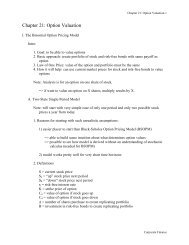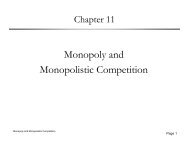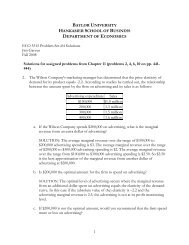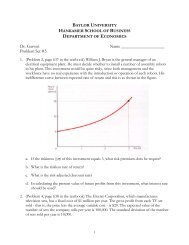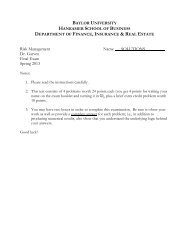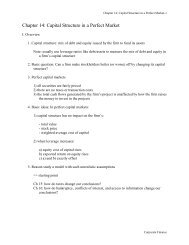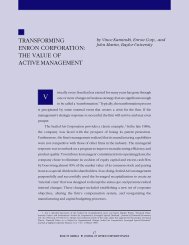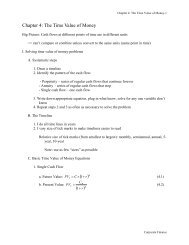Insurance Company Capital Structure Swaps and Shareholder Wealth
Insurance Company Capital Structure Swaps and Shareholder Wealth
Insurance Company Capital Structure Swaps and Shareholder Wealth
You also want an ePaper? Increase the reach of your titles
YUMPU automatically turns print PDFs into web optimized ePapers that Google loves.
Ej is value of equity, Aj is current value of assets <strong>and</strong> Lj is expected value of loss liabilities.<br />
The function N (•) is a draw from the st<strong>and</strong>ard normal distribution function.<br />
ln<br />
d1 =<br />
Aj<br />
Lj<br />
<br />
+ 0.5V 2<br />
j t<br />
√<br />
√ , d2 = d1 − Vj t<br />
t<br />
Vj<br />
V 2<br />
j = σ 2 jA + σ 2 jL − 2ρjALσjAσjL<br />
j takes the value of M for market value of equity <strong>and</strong> I for insider value of equity, σjk is the<br />
st<strong>and</strong>ard deviation of the variable k (either A for assets or L for losses) under j, <strong>and</strong> t is time to<br />
policy expiration. Note that V 2<br />
j is the instantaneous variance of the portfolio of long assets <strong>and</strong><br />
short liabilities, <strong>and</strong> for simplicity, probability distributions for assets <strong>and</strong> liabilities are stable over<br />
time. 8<br />
4.2 The Swap<br />
If managers believe that reinsurance will add value for the firm, they may be able to enrich con-<br />
trolling shareholders by purchasing reinsurance with the proceeds of a new equity issue. However,<br />
a firm can use excess cash to adjust to a desired capital structure without incurring flotation costs.<br />
Alternatively, managers could enrich controlling shareholders by selling more policies, using the<br />
proceeds to reduce outst<strong>and</strong>ing equity <strong>and</strong> thereby increase leverage if they believed that they<br />
could sell policies at a sufficient premium or retire equity at a sufficient discount. Managers need<br />
not retire equity to make such a swap worthwhile if they chose instead to use policy-generated cash<br />
to finance new projects or increase capital levels to satisfy regulators.<br />
When the manager chooses to undertake a capital structure swap, they will essentially increase<br />
or reduce the expected value of the loss reserves by some proportion α. When 0 < α < 1, the<br />
manager is purchasing reinsurance funded by an equity issue. When α > 1, the manager is issuing<br />
8 Some may suggest that these models require continuous trading <strong>and</strong> publicly tradable securities. First, as already<br />
shown, Rubinstein (1976) derives the option pricing model in a discrete time framework. Second, while it may not<br />
seem obvious at first, loss reserves are increasingly tradable. There has been a liquid reinsurance market in the<br />
developed world for decades, constantly swapping risks <strong>and</strong> trading risk for cash. In addition, the past decade has<br />
seen the proliferation of loss securitization, in which losses are bundled <strong>and</strong> sold to investors in exchange for LIBOR<br />
plus risk premium coupons. Thus, these constraints should not apply to use of an option pricing model in this context.<br />
13



